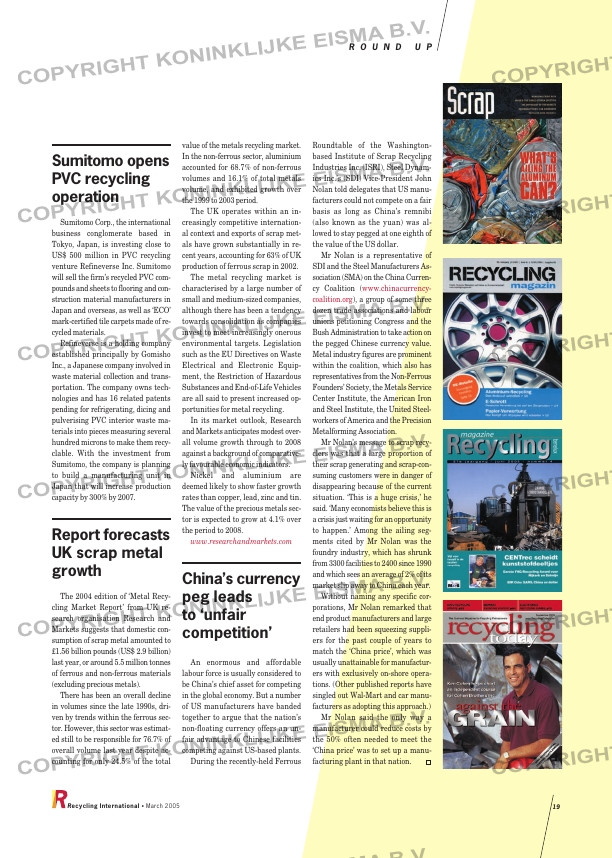Page 19 from: March 2005

Sumitomo opens
PVC recycling
operation
Sumitomo Corp., the international
business conglomerate based in
Tokyo, Japan, is investing close to
US$ 500 million in PVC recycling
venture Refineverse Inc. Sumitomo
will sell the firm’s recycled PVC com-
pounds and sheets to flooring and con-
struction material manufacturers in
Japan and overseas, as well as ‘ECO’
mark-certified tile carpets made of re-
cycled materials.
Refineverse is a holding company
established principally by Gomisho
Inc., a Japanese company involved in
waste material collection and trans-
portation. The company owns tech-
nologies and has 16 related patents
pending for refrigerating, dicing and
pulverising PVC interior waste ma-
terials into pieces measuring several
hundred microns to make them recy-
clable. With the investment from
Sumitomo, the company is planning
to build a manufacturing unit in
Japan that will increase production
capacity by 300% by 2007.
Report forecasts
UK scrap metal
growth
The 2004 edition of ‘Metal Recy-
cling Market Report’ from UK re-
search organisation Research and
Markets suggests that domestic con-
sumption of scrap metal amounted to
£1.56 billion pounds (US$ 2.9 billion)
last year, or around 5.5 million tonnes
of ferrous and non-ferrous materials
(excluding precious metals).
There has been an overall decline
in volumes since the late 1990s, dri-
ven by trends within the ferrous sec-
tor. However, this sector was estimat-
ed still to be responsible for 76.7% of
overall volume last year despite ac-
counting for only 24.5% of the total
value of the metals recycling market.
In the non-ferrous sector, aluminium
accounted for 68.7% of non-ferrous
volumes and 16.1% of total metals
volume, and exhibited growth over
the 1999 to 2003 period.
The UK operates within an in-
creasingly competitive internation-
al context and exports of scrap met-
als have grown substantially in re-
cent years, accounting for 63% of UK
production of ferrous scrap in 2002.
The metal recycling market is
characterised by a large number of
small and medium-sized companies,
although there has been a tendency
towards consolidation as companies
invest to meet increasingly onerous
environmental targets. Legislation
such as the EU Directives on Waste
Electrical and Electronic Equip-
ment, the Restriction of Hazardous
Substances and End-of-Life Vehicles
are all said to present increased op-
portunities for metal recycling.
In its market outlook, Research
and Markets anticipates modest over-
all volume growth through to 2008
against a background of comparative-
ly favourable economic indicators.
Nickel and aluminium are
deemed likely to show faster growth
rates than copper, lead, zinc and tin.
The value of the precious metals sec-
tor is expected to grow at 4.1% over
the period to 2008.
www.researchandmarkets.com
China’s currency
peg leads
to ‘unfair
competition’
An enormous and affordable
labour force is usually considered to
be China’s chief asset for competing
in the global economy. But a number
of US manufacturers have banded
together to argue that the nation’s
non-floating currency offers an un-
fair advantage to Chinese facilities
competing against US-based plants.
During the recently-held Ferrous
Roundtable of the Washington-
based Institute of Scrap Recycling
Industries Inc. (ISRI), Steel Dynam-
ics Inc.’s (SDI) Vice-President John
Nolan told delegates that US manu-
facturers could not compete on a fair
basis as long as China’s remnibi
(also known as the yuan) was al-
lowed to stay pegged at one eighth of
the value of the US dollar.
Mr Nolan is a representative of
SDI and the Steel Manufacturers As-
sociation (SMA) on the China Curren-
cy Coalition (www.chinacurrency-
coalition.org), a group of some three
dozen trade associations and labour
unions petitioning Congress and the
Bush Administration to take action on
the pegged Chinese currency value.
Metal industry figures are prominent
within the coalition, which also has
representatives from the Non-Ferrous
Founders’ Society, the Metals Service
Center Institute, the American Iron
and Steel Institute, the United Steel-
workers of America and the Precision
Metalforming Association.
Mr Nolan’s message to scrap recy-
clers was that a large proportion of
their scrap generating and scrap-con-
suming customers were in danger of
disappearing because of the current
situation. ‘This is a huge crisis,’ he
said. ‘Many economists believe this is
a crisis just waiting for an opportunity
to happen.’ Among the ailing seg-
ments cited by Mr Nolan was the
foundry industry, which has shrunk
from 3300 facilities to 2400 since 1990
and which sees an average of 2% of its
market slip away to China each year.
Without naming any specific cor-
porations, Mr Nolan remarked that
end product manufacturers and large
retailers had been squeezing suppli-
ers for the past couple of years to
match the ‘China price’, which was
usually unattainable for manufactur-
ers with exclusively on-shore opera-
tions. (Other published reports have
singled out Wal-Mart and car manu-
facturers as adopting this approach.)
Mr Nolan said the only way a
manufacturer could reduce costs by
the 50% often needed to meet the
‘China price’ was to set up a manu-
facturing plant in that nation.
R O U N D U P
Recycling International • March 2005 19



